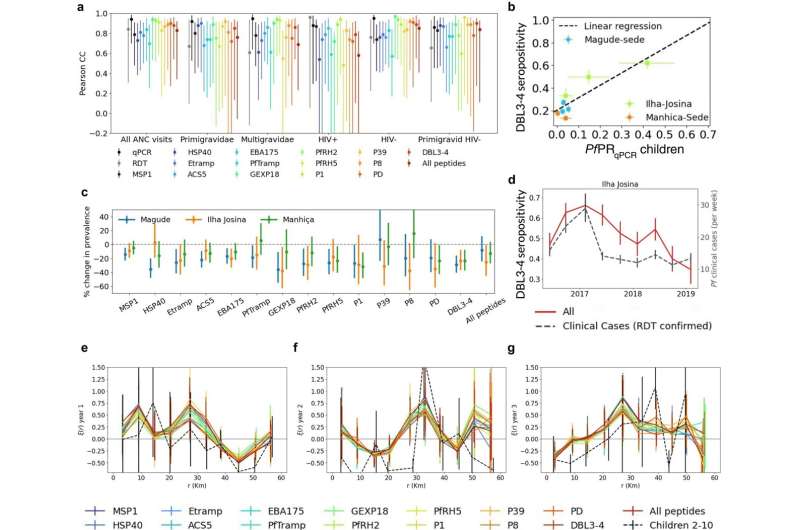This article has been reviewed according to Science X's editorial process and policies. Editors have highlighted the following attributes while ensuring the content's credibility:
fact-checked
peer-reviewed publication
trusted source
proofread
Pregnant women can contribute to malaria surveillance in sub-Saharan Africa

P. falciparum infection rates in pregnant women attending their first antenatal care visit can be used to estimate the burden of malaria in children living in the community, according to a study led by the Barcelona Institute of Health (ISGlobal) and the Centre for Health Research in Manhica (CISM). The study, published in Nature Communications, confirms that pregnant women are an optimal population to monitor changes in infection prevalence and to adapt control measures.
Close monitoring of malaria trends in a community or region (i.e. whether it is increasing or decreasing) is essential to adjust interventions aimed at controlling or eliminating the disease. However, relying on clinical cases that arrive at health centers is not ideal, as there are many patients who do not seek care or are asymptomatic. On the other hand, cross-sectional studies (i.e. collecting data from many people at the same time) are expensive and can only be carried out every two to three years.
For Alfredo Mayor, researcher at ISGlobal and CISM, pregnant women attending antenatal care visits are an optimal group to monitor the prevalence of malaria and other infectious diseases. "In sub-Saharan Africa, 79% of pregnant women attend at least one antenatal care visit, which is a good representation of the total population," notes Mayor. "In addition, antenatal visits have the advantage of capturing asymptomatic infections because they are independent of whether the person feels unwell."
In this study, Mayor and his team measured malaria prevalence in 6,471 pregnant women attending antenatal care visits in three areas of southern Mozambique with different levels of transmission (Manhiça, Magude and Ilha Josina) and compared it with the prevalence estimated from clinical cases or from cross-sectional studies in children, in the same areas and over the same time period (2016-2019).
Good temporal and spatial correlation
The analysis shows that infection rates in pregnant women closely reflect the rates in children from cross-sectional studies, especially when the parasite is detected by molecular tests (PCR). With rapid diagnostic tests, the correlation holds in low-transmission areas (Manhiça or Magude), but is lost in high-transmission areas (Ilha Josina) when multigravid women (who have had more than one pregnancy) are included. Multigravid women had a lower prevalence than the children in the community.
"This is because the immunity acquired during previous pregnancies allows them to maintain low parasite densities and evade detection by rapid tests, which are less sensitive than PCR," explains Arnau Pujol, co-first author of the study with Gloria Matambisso.
The results also show a good correlation over time between the declining infection rates in pregnant women and that of clinical cases, albeit with a lag of about three months (i.e. infection rates in pregnant women followed the same pattern as those in clinical cases, but with a delay of 2-3 months). This correlation was observed in all three sites, regardless of whether the woman was primigravida, multigravida or HIV-positive.
Finally, 60% of the infection hotspots identified with the clinical cases were also found with the pregnant women, thanks to a software that identifies cases that are geographically close.
"Our study shows that screening for P. falciparum at the first antenatal care visit can be used to estimate disease burden in children," says Matambisso. However, the authors warn that it is important to consider the delay of about three months compared to clinical cases, as well as the need to exclude multigravid women in high-transmission areas or to use more sensitive tests.
More information: Arnau Pujol et al, Detecting temporal and spatial malaria patterns from first antenatal care visits, Nature Communications (2023). DOI: 10.1038/s41467-023-39662-4




















